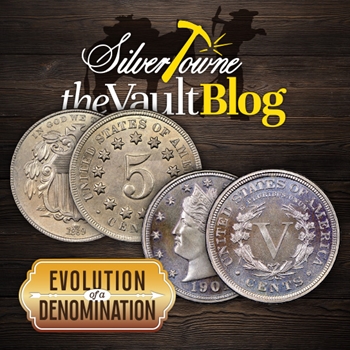
Nickel coins are something that is still very familiar today. One or two can most likely be found in coin purses, pockets, and vehicle consoles as they remain a staple in United States coinage. However, like a lot of early United States coinage, it has seen its fair share of design changes and metal compositions. Early five-cent pieces were replacements of five-cent fractional notes and as the Chief Engraver of the United States Min, James B. Longacre was commissioned with creating the new design.
Shield Nickels (1866-1883)
Made possible by the Act of May 16, 1866, the Shield nickel weighed five grams and was comprised of 75% copper and 25% nickel. Struck at only Philadelphia, the first year of production saw over 14.7 million coins minted with over 600 Proof issues coined. The design featured a Union Shield with crossed bows behind and towards the bottom of the shield on the obverse. This particular design aspect was very similar to the 1864 two-cent piece. “IN GOD WE TRUST'' appears above the shield along the top arc with the date appearing at the bottom. The reverse of the design shows a large ‘5’ in the center with a circle of stars and rays surrounding it. Inscribed along the outer portion of the coin are the words “UNITED STATES OF AMERICA” and “CENTS.”
The design of the shield nickel did not change except for when the United States Mint decided to get rid of the rays on the reverse. Some of the original design was minted in 1867 until it was changed shortly after. This caused there to be two varieties in the year 1867. Variety 1 features the rays and Variety 2 does not. In fact, a low mintage of 2,019,00 coins was produced for the Variety 1 with around 25 Proof versions being produced. The Proof version is one of the rarest coins in the series but also among United States coinage in general.
Liberty Head (1883-1913)
Early 1883 saw the change from Shield nickels to the Liberty Head design. The first year also saw a Variety 1 and Variety 2 in 1883 as coins with the initial design were being gold plated and passed along as $5 gold pieces.
The design, created by Charles E. Barber, features the head of Liberty with 13 stars surrounding her on the obverse. The word “LIBERTY” is inscribed on the coronet she is wearing with the date featured at the very bottom. The reverse of the design features a large ‘V’ in the center surrounded by a wreath as it is the Roman numeral for “5.” Variety 1 from 1883 features the words “E PLURIBUS UNUM” at the bottom while Variety 2 from 1883-1913 features the word “CENTS” at the bottom.
Again, problems with counterfeiting and fraudulence enabled the difference between the two strikes in 1883. Over 5.4 million coins were struck “Without CENTS” and over 16 million were struck “With CENTS” in 1883.
The Official 2021 Red Book; NGCCoin.com







